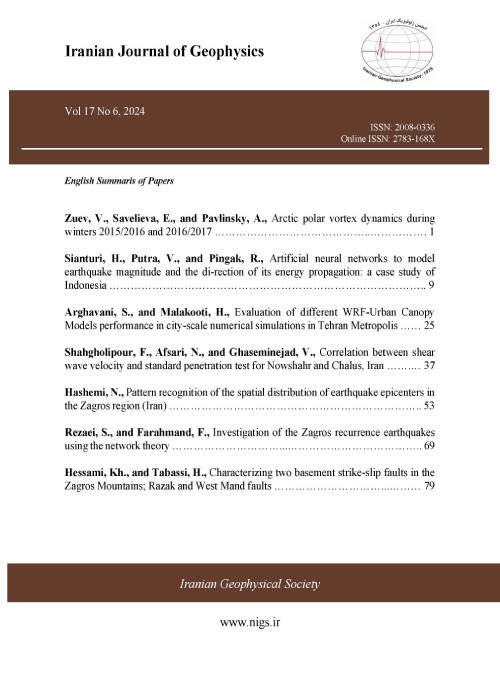Calculation of the downward continuation of the gravity data using iterative and Fourier transform methods
Author(s):
Abstract:
The downward continuation of the gravity data is one of the main issues of a geophysical data interpretation. Considering that the downward continuation of the gravity data is calculated on a plane under the ground and close to an anomaly, this gravity value could show the specifications of the anomaly better than the gravity anomaly on the ground. Factors such as shape, size and depth of the anomaly are determined by calculating the downward continuation of the gravity data.The upward and downward continuation is usually calculated by the Fourier transform (FT) method. The upward continuation calculated from FT method is stable. In this method, the upward continuation is calculated in a horizontal plane above the ground level. The higher frequencies (the shorter wavelengths) of the gravity data become damped in the calculation of the upward continuation. The amount of the downward continuation calculated by the FT method is unstable. The downward continuation is estimated in a horizontal plane lower than the ground level. The higher frequencies (the shorter wavelengths) of the gravity data are strengthened in the calculation of the downward continuation to a large extent which is a function of the downward continuation depth and the sampling interval. When the depth is several times bigger than the sampling interval, the downward continuation of the FT method is divergent, because the exponential function is positive; therefore, the noise will be dominated and the anomaly shape will disappear. Any existing and perhaps non-obvious errors in the measured data in the calculated field are very big and have unrealistic changes. The iterative method for calculating the downward continuation is a new one. In this method, using a change of variable, the amount of the gravity on the ground level is attributed to the desired horizontal plane −on which the downward continuation of the gravity data is calculated− as an initial value of the gravity. The upward continuation of the initial value of the gravity data on the ground level is calculated (with a height equal to the depth of the downward continuation). The difference between the initial value of the gravity data on the desired horizontal plane and the amount of the upward continuation is added to the initial value. These calculations are placed in a loop and the calculations of the loop are stopped when a predetermined accuracy is reached. Usually, the optimum downward continuation is gained after 100 to 200 iterations. The final value is placed as the amount of the downward continuation of the gravity data. This method is implemented in MATLAB and is run for the synthetic, synthetic with noise and real models. Considering that the amounts of the gravity data changes for the synthetic models and synthetic with noise models are low, the amount of the calculated gravity from the iterative method is stable. The limits of anomaly in the downward continuation of the studied models are preserved in all the forms, and the amount of the gravity near the horizontal planes of anomaly is greater than the gravity value at the ground level.
Keywords:
Language:
Persian
Published:
Iranian Journal of Geophysics, Volume:7 Issue: 1, 2013
Page:
105
magiran.com/p1138078
دانلود و مطالعه متن این مقاله با یکی از روشهای زیر امکان پذیر است:
اشتراک شخصی
با عضویت و پرداخت آنلاین حق اشتراک یکساله به مبلغ 1,390,000ريال میتوانید 70 عنوان مطلب دانلود کنید!
اشتراک سازمانی
به کتابخانه دانشگاه یا محل کار خود پیشنهاد کنید تا اشتراک سازمانی این پایگاه را برای دسترسی نامحدود همه کاربران به متن مطالب تهیه نمایند!
توجه!
- حق عضویت دریافتی صرف حمایت از نشریات عضو و نگهداری، تکمیل و توسعه مگیران میشود.
- پرداخت حق اشتراک و دانلود مقالات اجازه بازنشر آن در سایر رسانههای چاپی و دیجیتال را به کاربر نمیدهد.
In order to view content subscription is required
Personal subscription
Subscribe magiran.com for 70 € euros via PayPal and download 70 articles during a year.
Organization subscription
Please contact us to subscribe your university or library for unlimited access!


